 Last additions - HYOGO 兵庫県 Last additions - HYOGO 兵庫県 |

Corridor on an upper floor.Oct 07, 2018
|
|

Vintage cameraOct 07, 2018
|
|

Electronical appliances.Oct 07, 2018
|
|

Emigrants' luggage.Oct 07, 2018
|
|

Sports equipment.Oct 07, 2018
|
|

Japanese language textbooks.Oct 07, 2018
|
|

This is how the sleeping quarters looked like at the Kobe emigration center.Oct 07, 2018
|
|

This is how the sleeping quarters looked like at the Kobe emigration center.Oct 07, 2018
|
|

This is how the sleeping quarters looked like at the Kobe emigration center.Oct 07, 2018
|
|

Lodging facility reconstructed here.Oct 07, 2018
|
|
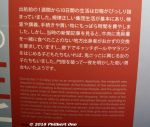
Life in the emigration center.Oct 07, 2018
|
|
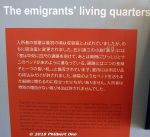
Emigrant's living quarters.Oct 07, 2018
|
|

Exhibition roomOct 07, 2018
|
|

Pictures of emigrants.Oct 07, 2018
|
|

Statue of emigrants to Brazil. This same statue also stands at Meriken Park in Kobe.Oct 07, 2018
|
|
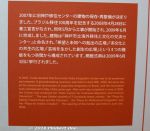
History of the emigrant center: 2007-2009Oct 07, 2018
|
|
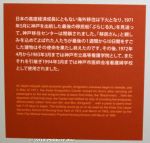
History of the emigrant center: 1970s-80s as a School of Nursing.Oct 07, 2018
|
|
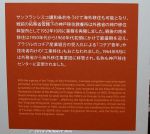
History of the emigrant center: 1950s-60sOct 07, 2018
|
|
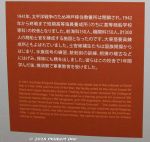
History of the emigrant center: 1940sOct 07, 2018
|
|
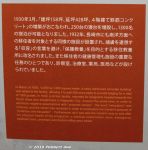
History of the emigrant center: 1930sOct 07, 2018
|
|

History of the emigrant center.Oct 07, 2018
|
|

It took over 50 days to travel from Japan to South America.Oct 07, 2018
|
|

Travel routes from Japan to South America.Oct 07, 2018
|
|

Emigrant ship to South America.Oct 07, 2018
|
|

Farm toolsOct 07, 2018
|
|

Room showing farm tools.Oct 07, 2018
|
|

Map of Kobe Port on the floor.Oct 07, 2018
|
|
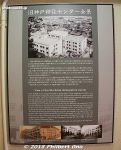
Old Kobe Immigration Center.Oct 07, 2018
|
|

The 1st and 2nd floors have the emigration exhibition rooms. The 3rd floor is mainly offices of local Brazilian groups, and the 4th floor has rented studios for artists.Oct 07, 2018
|
|

Portuguese notices.Oct 07, 2018
|
|

Entrance.Open 10:00 am -5:00 pm (enter by 4:30 pm), closed Mon. (open if a national holiday and closed on Tue. instead) and December 29 to January 3. Admission: FreeOct 07, 2018
|
|

Monument for the "Birthplace of Japan's Emigration to Brazil" (ブラジル移民発祥の地)Oct 07, 2018
|
|

It is also has a consultation center for South American residents of Kobe. Operated by the city of Kobe, the current facility opened on June 3, 2009.15-min. walk from JR Motomachi Station (East Exit) on the JR Tokaido/Kobe Line. Walk straight along Koikawa-suji road (鯉川筋). Or 10-min. walk from Kencho-mae Station on the subway line. From JR Shin-Kobe Station (shinkansen), 10-min. taxi ride.Oct 07, 2018
|
|

During World War II, the facility was used by the Japanese military. Then it became a school for hospital nurses. Today, the building is a South America emigration museum and the base for the Kansai Brazilian Community.There are exhibition rooms showing Kobe's history of Japanese immigration, especially to South America. Art studios, art gallery spaces, and meeting rooms are also provided for cultural exchange. Oct 07, 2018
|
|

This was where the Japanese immigrants would stay for up to 10 days to prepare for their long boat journey and move to South America.Today, the center is partially a museum where a few of the old rooms used by the emigrants have been restored. Other rooms are rented, including an event hall, meeting rooms, and gallery spaces. It includes a consultation center for South American residents of Kobe.
Museu da Emigração e Centro de Intercâmbio Cultural de KobeOct 07, 2018
|
|

Kobe Center for Overseas Migration and Cultural Interaction was originally the National Emigration Center (国立移民収容所) where Japanese immigrants stayed for orientation before traveling mainly to South America (especially Brazil) by boat.The Emigration Center was used from 1928 to 1971 and it's Japan's only surviving building used for sending Japanese immigrants. Later renamed Kobe Emigrant Education Center and then Kobe Emigrant Assistance Center and Kobe Emigration Center (神戸移住センター).Oct 07, 2018
|
|

Video of Toka Ebisu at Nishinomiya Shrine, Hyogo.Jan 10, 2011
|
|
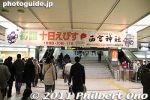
Toka Ebisu banner inside Umeda Station.Jan 10, 2011
|
|
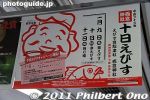
Toka Ebisu ad inside Hanshin Line train.Jan 10, 2011
|
|
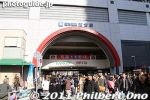
Hanshin Nishinomiya Station.Jan 10, 2011
|
|
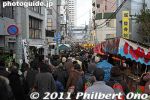
Way to Hanshin Nishinomiya Station.Jan 10, 2011
|
|
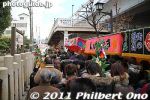
Very narrow path back to the station.Jan 10, 2011
|
|
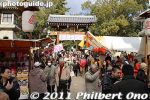
Exiting Nishinomiya Shrine.Jan 10, 2011
|
|
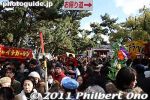
People on the left are heading for the shrine, while people on the right are leaving.Jan 10, 2011
|
|
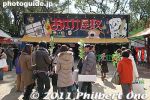
House of Horros amusement even.Jan 10, 2011
|
|
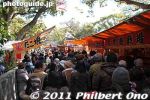
Jan 10, 2011
|
|
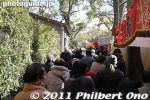
Jan 10, 2011
|
|

Leaving the shrine was on a narrow, long path.Jan 10, 2011
|
|
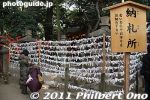
OmikujiJan 10, 2011
|
|
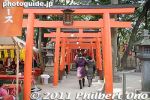
Shinmei ShrineJan 10, 2011
|
|
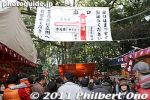
Way homeJan 10, 2011
|
|
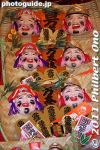
Jan 10, 2011
|
|
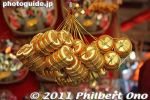
Jan 10, 2011
|
|
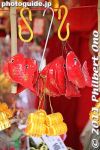
Jan 10, 2011
|
|
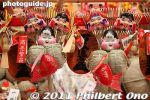
Jan 10, 2011
|
|
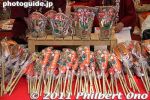
Jan 10, 2011
|
|
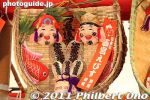
Ebisu decorationsJan 10, 2011
|
|
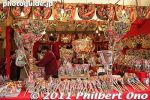
Jan 10, 2011
|
|
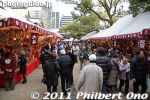
The shrine also had numerous stalls selling Ebisu decorations.Jan 10, 2011
|
|
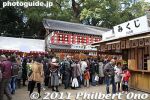
Here's the cheap 100-yen omikuji line, much longer than the one for the 300-yen omikuji.Jan 10, 2011
|
|
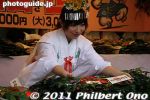
Jan 10, 2011
|
|
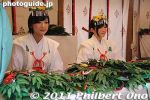
Shrine maidens selling fuku-sasa branches at Nishinomiya Shrine's Toka Ebisu.Jan 10, 2011
|
|
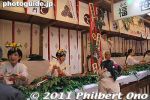
Compared to Imamiya Shrine, they weren't so busy selling fuku-zasa branches.Jan 10, 2011
|
|
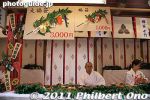
Jan 10, 2011
|
|
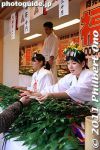
At Osaka's Imamiya Shrine (another big Ebisu shrine), the tree branches are real and you can choose which decorations to put on it.Jan 10, 2011
|
|
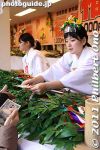
Nishinomiya Shrine maiden selling Fuku-zasa tree branches for Toka Ebisu. I was disappointed that the branches were plastic and all the decorations were already on them.Jan 10, 2011
|
|
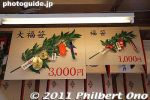
Fuku-zasa branches cost 1000 or 3000 yen.Jan 10, 2011
|
|
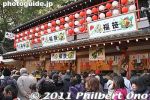
Fuku-zasa tree branches for prosperity and good fortune sold here.Jan 10, 2011
|
|
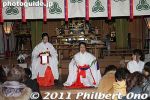
Jan 10, 2011
|
|
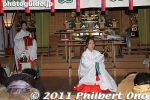
Pay a fee to enter this little hall to be blessed with a sacred dance.Jan 10, 2011
|
|
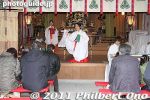
Sacred dancer.Jan 10, 2011
|
|
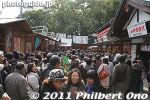
Proceed further to see more vendors.Jan 10, 2011
|
|

About Hyakudayu Shrine.Jan 10, 2011
|
|
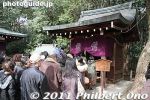
Hyakudayu ShrineJan 10, 2011
|
|

About Homusubi Shrine.Jan 10, 2011
|
|
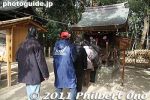
Homusubi ShrineJan 10, 2011
|
|
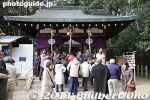
Smaller shrines in Nishinomiya Shrine.Jan 10, 2011
|
|

About the tai sea bream.Jan 10, 2011
|
|
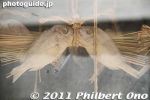
Tai sea bream pair.Jan 10, 2011
|
|
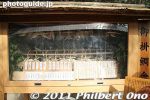
Tai sea bream display case.Jan 10, 2011
|
|

Ema tablets at Nishinomiya Shrine.Jan 10, 2011
|
|
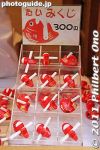
Nishinomiya Shrine's 300-yen omikuji comes with a cute tai (sea bream).Jan 10, 2011
|
|
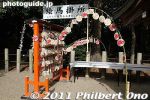
Ema tablets.Jan 10, 2011
|
|
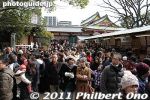
Exiting the Honden.Jan 10, 2011
|
|
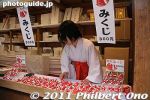
Selling omikuji fortunes.Jan 10, 2011
|
|
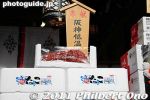
Offering of octopus (tako).Jan 10, 2011
|
|
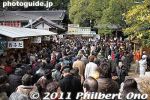
Scene after you exit the Honden.Jan 10, 2011
|
|
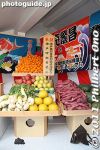
Fruits and vegetable offerings from the local produce cooperative.Jan 10, 2011
|
|
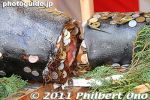
Where the tail is cut off.Jan 10, 2011
|
|
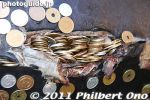
They stuffed coins in every crack and crevice of the fish. I wonder who's gonna eat the fish afterward.Jan 10, 2011
|
|
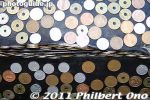
Jan 10, 2011
|
|
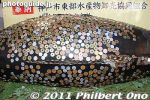
Coins stuck on giant tune at Nishinomiya Shrine Toka Ebisu.Jan 10, 2011
|
|
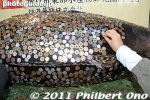
Jan 10, 2011
|
|
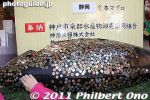
By this time, the tuna was dry and solid as a rock. It was impossible to stick on more coins.Jan 10, 2011
|
|
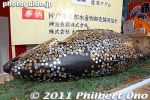
The tradition is to stick on coins on the tuna.Jan 10, 2011
|
|
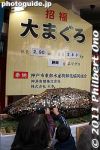
The tuna is 2.9 meters long weighing 280 kg. About the same as two sumo wrestlers.Jan 10, 2011
|
|
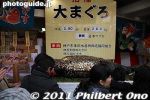
Jan 10, 2011
|
|
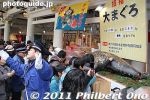
They also had a giant maguro tuna fish on display as an offering to the shrine from a fishing cooperative.Jan 10, 2011
|
|
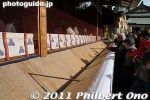
The Honden had this narrow but long offertory box. Surprisingly small for a huge occasion as this.Jan 10, 2011
|
|
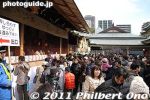
After passing through the Haiden, there's the Honden main worship hall, the shrine's main building.Jan 10, 2011
|
|
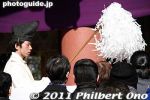
They also waved sacred staffs over our heads as we entered the Haiden.Jan 10, 2011
|
|

About the upside down kadomatsu.Jan 10, 2011
|
|
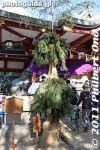
Something unique is this upside down kadomatsu decoration flanking Nishinomiya Shrine's Haiden Hall.Jan 10, 2011
|
|
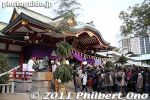
Entering the Nishinomiya Shrine's Haiden Hall.Jan 10, 2011
|
|
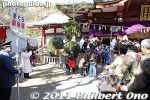
On the left was a separate entrance here to see the giant tuna (maguro).Jan 10, 2011
|
|
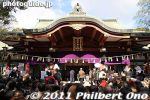
Nishinomiya Shrine's Haiden Hall. It took about 30 min. to get here from Akamon Gate.Jan 10, 2011
|
|
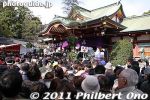
Nishinomiya Shrine worships a god named Hiruko (蛭子), also known as Ebisu, one of the Seven Gods of Fortune. Ebisu is regarded as the god of fishermen and good fortune depicted as a rotund, bald man holding a tai sea bream.Jan 10, 2011
|
|
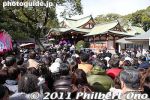
Haiden hall up ahead. Behind it is the Honden main hall.Jan 10, 2011
|
|
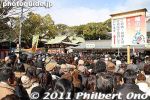
Jan 10, 2011
|
|
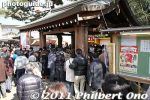
Wash basin to purify yourself. Few people stopped here.Jan 10, 2011
|
|
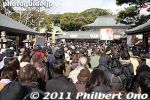
Jan 10, 2011
|
|
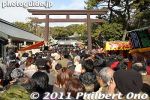
But we got nearer and nearer so it wasn't so bad and it wasn't taking forever.Jan 10, 2011
|
|
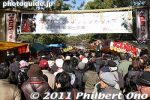
It's a stop-and-go process.Jan 10, 2011
|
|
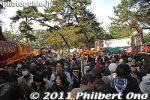
People on the left are leaving the shrine, while people on the right are heading for the shrine. About a million people visit Nishinomiya Shrine during Jan. 9-11.Jan 10, 2011
|
|
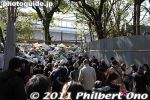
Along the way, there was a place where you could throw away your old Ebisu decorations.Jan 10, 2011
|
|
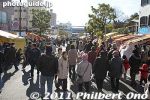
Ebessan-suji road going to Nishinomiya Jinja Shrine.Jan 10, 2011
|
|
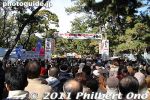
Jan 10, 2011
|
|
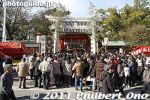
Entering Nishinomiya Shrine at the Omote Daimon Gate, usually called Akamon Gate. 西宮神社表大門 通称赤門Jan 10, 2011
|
|
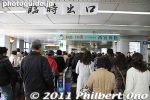
Exiting Hanshin Nishinomiya Station on Jan 10, 2011.Jan 10, 2011
|
|

Barrels of sake displayed for Toka Ebisu inside Hanshin Nishinomiya Station.Jan 10, 2011
|
|
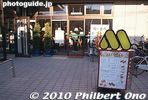
I was amazed to see Mos Burger back in business so soon. It was another sign of a very progressive recovery.Jan 30, 2010
|
|
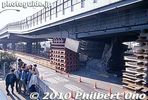
Earthquake tourists getting their picture taken.Jan 30, 2010
|
|

Fukae Shopping CenterJan 30, 2010
|
|
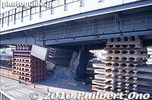
Jan 30, 2010
|
|

Jan 30, 2010
|
|

The expressway that supposed withstand such quakes collapsed. It was a major scandal. The shinkansen bullet train tracks also had broken concrete columns which revealed pieces of scrap wood mixed in. Jan 30, 2010
|
|

The engineers said this would be strong enough, but they were dead wrong.Jan 30, 2010
|
|

The famous scene of the expressway collapsed on its side was completely gone 10 days after the quake. They had cleared the collapsed section (about 600 meters) of the road.Jan 30, 2010
|
|

The collapsed expressway was so embarrassing that they made it a priority to clear it ASAP.Jan 30, 2010
|
|
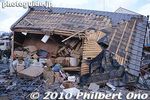
The Japanese tile roof makes the home top-heavy, making it more vulnerable to horizontal swaying and eventual toppling.Jan 30, 2010
|
|

When you look at these toppled homes, you cannot help but think that they do look flimsy with thin walls. The problem is, such cheaply-made homes are very common in Japan.Jan 30, 2010
|
|
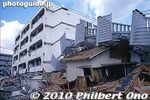
Something they needed the most was torn off the building. If you live in a high-rise building in Japan, have ropes ready in your veranda in case your stairway is destroyed like this.Jan 30, 2010
|
|
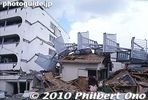
The emergency stairway got torn off this building whose first floor got crushed.Jan 30, 2010
|
|
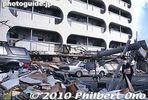
I really felt sorry for the people who had just bought a house or condo with a 35-year mortgage and the house or condo was destroyed by the quake. They are stuck paying off the housing loan and also have to pay monthly rent at a new place.Jan 30, 2010
|
|

Jan 30, 2010
|
|
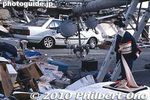
At least they recovered some things.Jan 30, 2010
|
|
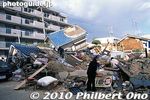
Sifting through the rubble.Jan 30, 2010
|
|
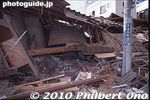
A makeshift altar placed on the collapsed home. Someone died here. By the time I visited, most of the trapped people had been rescued.Jan 30, 2010
|
|

Another distinct pattern was buildings on stilts easily collapsing.Jan 30, 2010
|
|

Sign says, "Keep our town beautiful."Jan 30, 2010
|
|
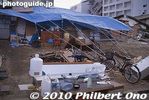
House covered by a blue tarp to protect against rain.Jan 30, 2010
|
|
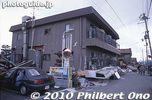
Collapsed 1st floor of an apt. building. I don't recommend living on the 1st floor of any building in Japan.Jan 30, 2010
|
|
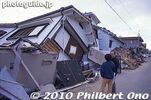
Houses along the train tracks in Ashiya. Basically, Japanese-style homes with heavy tile roofs collapsed easily, while concrete homes withstood the quake better.Jan 30, 2010
|
|
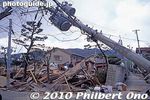
Jan 30, 2010
|
|

Not a good idea to live in a house standing right next to another building.Jan 30, 2010
|
|

This house stood firm, while its neighbor collapsed.Jan 30, 2010
|
|
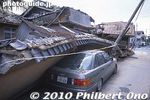
Crushed Audi.Jan 30, 2010
|
|
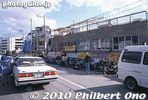
Collapsed shopping center near Ashiya Station. That's the 2nd floor which now looks like the 1st floor.Jan 30, 2010
|
|

Ashiya StationJan 30, 2010
|
|
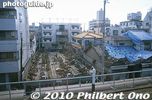
The next day, I again visited Kobe, this time by train to Ashiya Station. See gravestones overturned.Jan 30, 2010
|
|
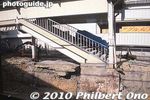
Ashiya Station platform.Jan 30, 2010
|
|

Jan 30, 2010
|
|
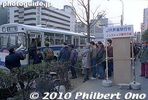
Bus for Ashiya Station, the furthest that trains could go at the time. Trains weren't running within Kobe.Jan 30, 2010
|
|
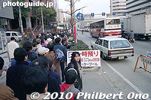
Line for the bus headed for Ashiya Station.Jan 30, 2010
|
|

Water stationJan 30, 2010
|
|
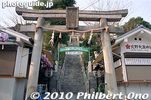
Jan 30, 2010
|
|
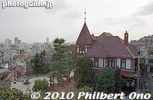
Only the chimney broke off atop the Weathercock House. The inside is a different story.Jan 30, 2010
|
|

Weathercock House, built in 1909, withstood the quake.Jan 30, 2010
|
|

In the Kitano area where there are many Western-style homes, the damage was not so apparent. But the interior sustained damage. None of the buildings collapsed though.Jan 30, 2010
|
|
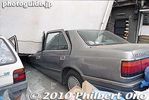
Crushed carJan 30, 2010
|
|

Boxes of food (biscuits).Jan 30, 2010
|
|

A building owner stands by her destroyed building.Jan 30, 2010
|
|
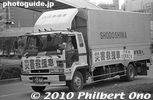
Truck carrying relief goods.Jan 30, 2010
|
|
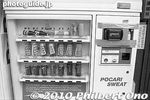
Vending machineJan 30, 2010
|
|
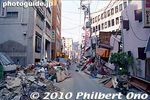
Backstreet destruction.Jan 30, 2010
|
|
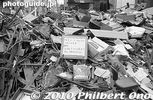
Sign saying they are okay.Jan 30, 2010
|
|
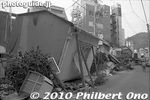
Jan 30, 2010
|
|

Jan 30, 2010
|
|

The 1st floor is totally flattened.Jan 30, 2010
|
|

One hotel guest escaped by using bed sheets as a rope.Jan 30, 2010
|
|

People eating yakisoba amid the rubble.Jan 30, 2010
|
|

Another common way in which buildings collapsed was the 1st floor giving way like this small hotel.Jan 30, 2010
|
|

Amid the rubble of a collapsed building, a yakisoba stall sold yakisoba noodles.Jan 30, 2010
|
|

Jan 30, 2010
|
|
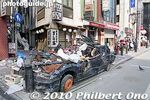
Crushed carJan 30, 2010
|
|
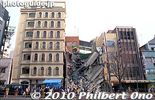
Interesting contrast between buildings which fell and didn't fall.Jan 30, 2010
|
|
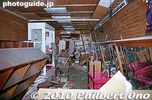
Store in shambles.Jan 30, 2010
|
|

Jan 30, 2010
|
|
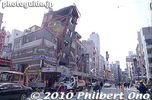
No, my camera lens is not distorting this picture. That building is actually tilting a lot, but they still allowed traffic on the road below.Jan 30, 2010
|
|

Fallen clock which stopped at the time of the earthquake.Jan 30, 2010
|
|

A mess inside a restaurant.Jan 30, 2010
|
|
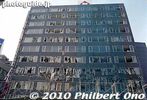
Nihon Seimei Bldg. collapsed at the middle, near Sannomiya Station. It's hard to imagine what would've happened if the quake struck during working hours with people working in this building.Jan 30, 2010
|
|

Nihon Seimei Bldg. collapsed at the middle.Jan 30, 2010
|
|

Jan 30, 2010
|
|
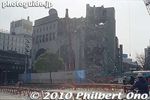
Hankyu Railways' Sannomiya Station being torn down.Jan 30, 2010
|
|

Sannomiya StationJan 30, 2010
|
|
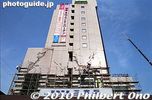
Damage to Sannomiya Station building.Jan 30, 2010
|
|

The building next to Washington Hotel scraped against the hotel as it fell.Jan 30, 2010
|
|
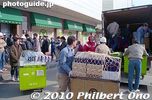
Employees are removing merchandise from Sogo Dept. Store.Jan 30, 2010
|
|
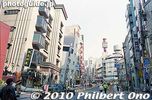
Tilted buildings near Sannomiya Station. It took only 15 sec. to wreak all this damage.Jan 30, 2010
|
|

Jan 30, 2010
|
|
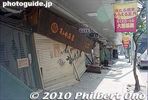
Shop shutters along Ikuta Road are tilted due to the crushing weight.Jan 30, 2010
|
|

Cracked Sogo Dept. Store in Sannomiya.Jan 30, 2010
|
|
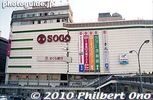
Sogo Dept. Store cracked vertically in the middle. This building was later torn down and replaced with a new dept. store building.Jan 30, 2010
|
|

In front of Sannomiya Station is Sogo Dept. Store.Jan 30, 2010
|
|
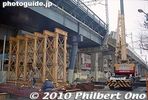
Expressway pylon broken.Jan 30, 2010
|
|

Kobe Shimbun newspaper offices near Sannomiya Station was in shambles.Jan 30, 2010
|
|

Kobe City Hall buckled at the middle floor.Jan 30, 2010
|
|

Santica building near Sannomiya Station had a middle floor crushed. As I walked around the devastation, I could see common ways in which the buildings collapsed. High rise buildings commonly collapsed on a middle floor.Jan 30, 2010
|
|

Near Kobe City Hall along Flower Road was this office building which had also collapsed at a middle floor.Jan 30, 2010
|
|

Distribution place for relief goods. Ten days after the earthquake, the initial fires, confusion, and pandemonium had subsided. It was pretty calm by then, but the damage was still visible.Jan 30, 2010
|
|

Kobe Port. Most of the people entering Kobe during this time were relatives and friends of Kobe residents, bringing relief goods.Jan 30, 2010
|
|

Since Jan. 2010 is the 15th anniversary of the Kobe earthquake that struck on Jan. 17, 1995, I decided to upload these photos for the first time. I visited Kobe 10 days after the killer quake struck. Had to take a hydrofoil from Osaka to reach Kobe.Jan 30, 2010
|
|

Kobe manholeJul 06, 2009
|
|

Apr 27, 2009
|
|

Apr 27, 2009
|
|

Apr 27, 2009
|
|

Apr 27, 2009
|
|

Apr 27, 2009
|
|

Apr 27, 2009
|
|

Apr 27, 2009
|
|

Hammack which Ben slept on.Apr 27, 2009
|
|

Apr 27, 2009
|
|

Apr 27, 2009
|
|

Apr 27, 2009
|
|

Apr 27, 2009
|
|

Animal rights activists will love this house.Apr 27, 2009
|
|

Apr 27, 2009
|
|

Ben's HouseApr 27, 2009
|
|

Apr 27, 2009
|
|

Apr 27, 2009
|
|

Apr 27, 2009
|
|

Apr 27, 2009
|
|

Full of big game animals.Apr 27, 2009
|
|

Apr 27, 2009
|
|

Glassware by Rene LaliqueApr 27, 2009
|
|

Largest head in the house, buffaloApr 27, 2009
|
|

Apr 27, 2009
|
|

Apr 27, 2009
|
|

Apr 27, 2009
|
|

Apr 27, 2009
|
|
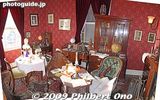
Sherlock Holmes room in British House, Kobe IjinkanApr 27, 2009
|
|

Apr 27, 2009
|
|

Apr 27, 2009
|
|

Apr 27, 2009
|
|

French HouseApr 27, 2009
|
|

Apr 27, 2009
|
|

Sherlock Holmes cloak and hatApr 27, 2009
|
|

Inside British HouseApr 27, 2009
|
|

Apr 27, 2009
|
|

Garden outside British HouseApr 27, 2009
|
|

Apr 27, 2009
|
|

Inside Rhine HouseApr 27, 2009
|
|

Apr 27, 2009
|
|

Kitano-dori road 北野通りApr 27, 2009
|
|

Apr 27, 2009
|
|

Apr 27, 2009
|
|

Apr 27, 2009
|
|

Apr 27, 2009
|
|

Apr 27, 2009
|
|

Apr 27, 2009
|
|

Apr 27, 2009
|
|
| 1000 files on 4 page(s) |
 |
3 |
|